How to Clean a Chicken Coop with a Dirt Floor: Best Practices for Hygiene
- March 22, 2024
- 0 comment
Ensuring your chickens thrive in a clean and conducive habitat is paramount, particularly when managing a coop with a dirt base. Conventional cleaning approaches typically rely on harsh chemicals that pose risks to both your poultry and the ecological balance.
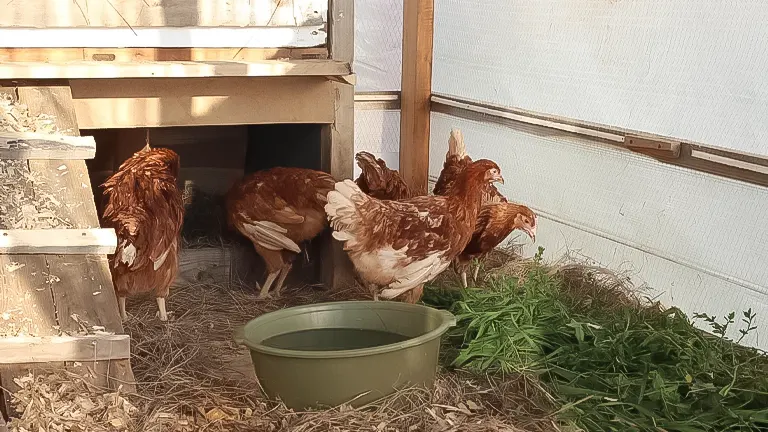
Through this detailed guide, we aim to introduce you to a sustainable and environmentally friendly method for maintaining your chicken coop’s cleanliness. This process emphasizes the utilization of recyclable materials, not only safeguarding the health of your birds but also contributing positively to environmental conservation.
List of How to Clean A Chicken Coop With A Dirt Floor:
- Assessing Your Coop’s Current Condition
- Gathering Eco-Friendly Materials
- Removing Old Bedding and Waste
- Adding a Layer of Char
- Incorporating Sawdust and Wood Chips
- Applying Food-Grade Diatomaceous Earth
Understanding The Basic of Cleaning A Chicken Coop With A Dirt Floor
Understanding the basics of cleaning a chicken coop with a dirt floor involves recognizing the balance between hygiene and maintaining a natural environment for your chickens. The key lies in routine assessments to identify ammonia build-up and parasite infestation, which are detrimental to poultry health.
Utilizing eco-friendly materials like char, sawdust, and wood chips not only aids in absorbing excess moisture and neutralizing odors but also enriches the floor with beneficial carbon content. The incorporation of food-grade diatomaceous earth targets parasites without harming the chickens. This approach emphasizes sustainability by repurposing waste materials and aligns with a holistic perspective on poultry care, ensuring a clean, safe, and healthy habitat that promotes the well-being of your flock and the environment.
Step 1: Assessing Your Coop’s Current Condition
Initiating the coop cleaning process begins with a thorough assessment of its condition. It’s essential to check for indicators of high ammonia levels, primarily from chicken droppings, which could adversely affect the respiratory health of your flock.
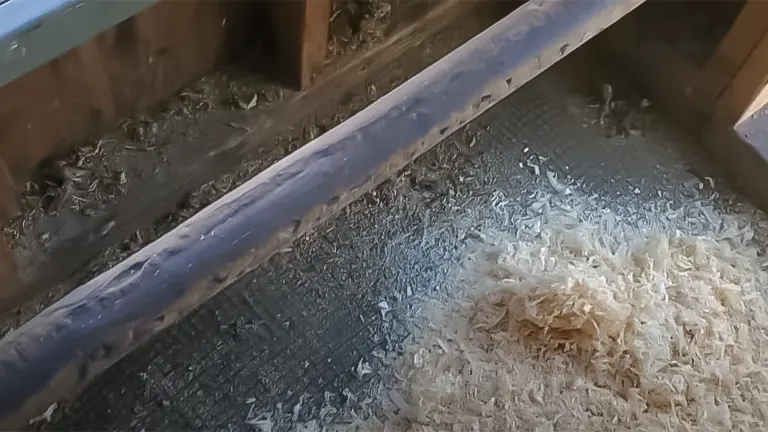
Early detection of these signs allows for timely cleanout, preventing potential health problems and simplifying the cleaning task.
Step 2: Gathering Eco-Friendly Materials
The approach here is to leverage readily accessible, cost-free waste materials for the cleaning process. These materials include:
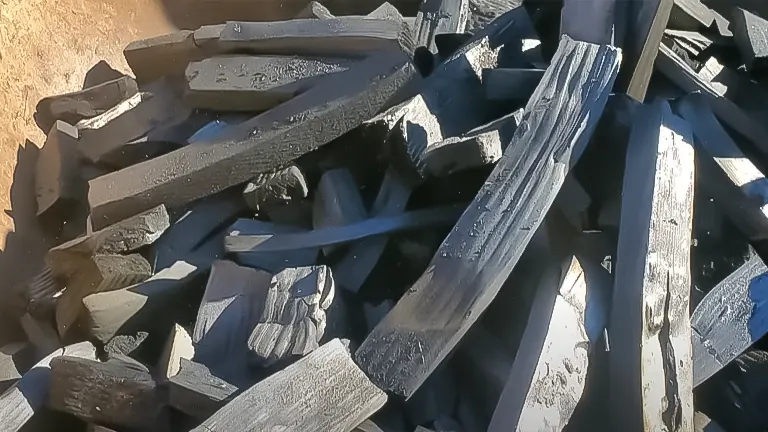
- Char: Derived from wood or agricultural remnants, char not only aids in minimizing odors but also acts as a precursor to biochar, enhancing the quality of compost.
- Sawdust and Wood Chips: Often available from local woodworkers or tree services, these by-products are ideal for bedding thanks to their high carbon content, which plays a critical role in managing moisture and odor.
- Food-Grade Diatomaceous Earth: This naturally occurring mineral is effective in parasite control, offering a safe solution for your chickens without posing any risk if consumed.
Step 3: Removing Old Bedding and Waste
The first active step in the cleaning process is the removal of all old bedding and accumulated waste. This action is pivotal in disease prevention and parasite control.
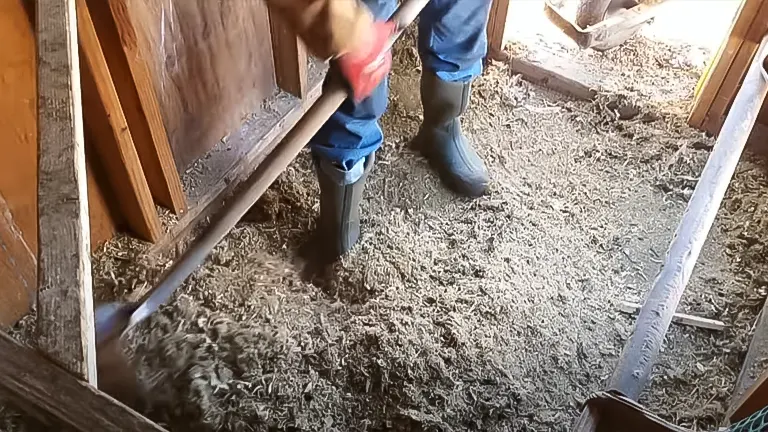
Responsibly disposing of or composting the waste aligns with eco-friendly practices, closing the loop in sustainable coop management.
Step 4: Adding a Layer of Char
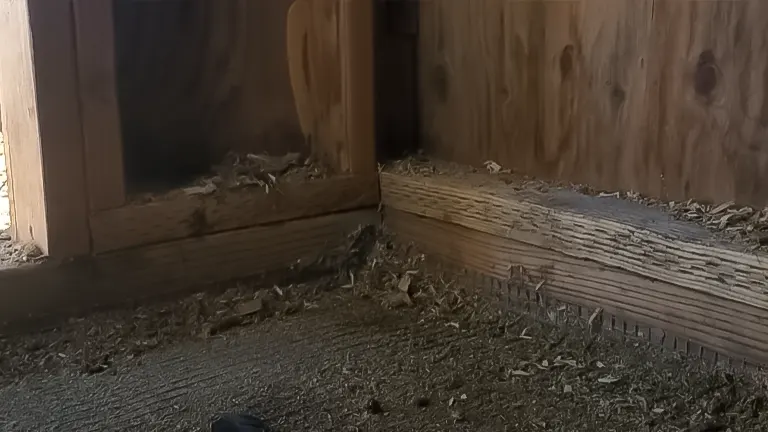
Applying a wet layer of char across the coop floor serves multiple functions. It reduces unpleasant odors, making the coop more comfortable for the chickens, and initiates the transformation into biochar. This addition enriches the compost, contributing to a healthier environment for your coop.
Step 5: Incorporating Sawdust and Wood Chips
The incorporation of sawdust and wood chips into the coop bedding is a strategic move to absorb excess moisture and enhance the bedding structure.
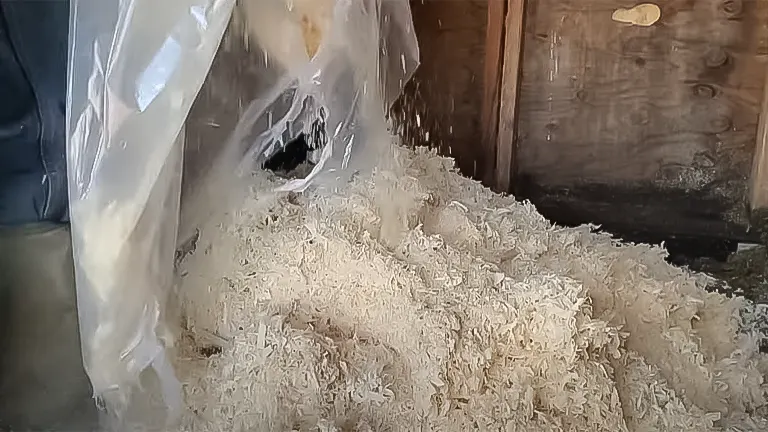
These carbon-rich materials counterbalance the high nitrogen levels in chicken manure, ensuring a balanced and healthy flooring material for the coop.
Step 6: Applying Food-Grade Diatomaceous Earth
The final step involves the application of food-grade diatomaceous earth around the coop, with a focus on roosting areas. This substance effectively wards off parasites, maintaining the health of your chickens.
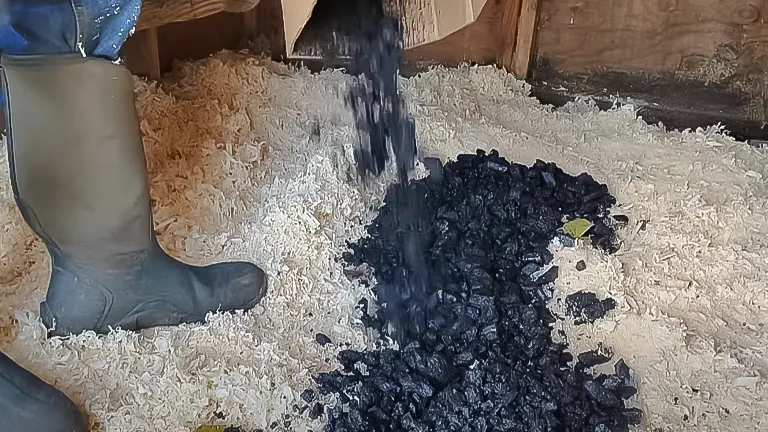
Its safety for consumption makes it an ideal choice for an environment where chickens might ingest it, ensuring their well-being while keeping parasites at bay.
Additional Tips for Maintaining a Healthy Coop
- Regular Scrubbing: Use a grill brush or similar tool to scrub roosts and remove manure buildup. This practice keeps the coop clean and reduces parasite load.
- Monitor Moisture Levels: Ensure the coop remains dry. Excess moisture can lead to mold and bacteria growth. Adjust the amount of sawdust or wood chips as needed to maintain dry bedding.
- Ventilation: Proper ventilation is vital in a chicken coop, especially with a dirt floor. It helps control ammonia levels and keeps the air fresh and healthy for your flock.
Choosing the Right Bedding Material
Sawdust and wood chips both serve as effective bedding materials, yet wood chips are frequently preferred for their lower dust production and enhanced capability to soak up moisture. The choice between these materials can be influenced by their local availability. Opting for these natural by-products, often sourced from community waste, not only cuts costs but also diminishes the ecological impact, supporting sustainable farming practices.
The Importance of Eco-Friendly Practices
Adopting an eco-friendly approach to coop cleaning not only supports your chickens’ health but also contributes to a sustainable planet. By using waste materials, we reduce landfill contributions and embrace a cycle of reuse that benefits our environments, both local and global.
In conclusion, cleaning a chicken coop with a dirt floor doesn’t have to be a daunting task. By following these eco-friendly steps and using readily available waste materials, you can create a healthy, sustainable environment for your chickens. This guide not only helps in maintaining a clean coop but also in promoting the well-being of your flock and the planet.
Related Articles:
- Best Bedding For Chickens
- Best Safe Chicken Coop Heater
- 8×8 Chicken Coop Plans
- Turning a Shed Into a Chicken Coop
- How to Make a Chicken Coop Out of Pallets
- Best Sand for Chicken Coop
- How To Insulate a Chicken Coop
- How To Heat a Chicken Coop
- How To Keep Water from Freezing in Chicken Coop
- How to Build a Chicken Coop
- How To Build Chicken Nesting Boxes
- How to Raise Happy and Healthy Chickens in Your Backyard
- When Can Chicks Go Outside? Timing and Tips for a Smooth Transition
- 12 Reasons why Ducks are Better than Chickens
- Best Automatic Chicken Coop Doors 2024: Expert Reviews & Buyer’s Guide
- Best Fans for Chicken Coop 2024: Effective Cooling Solutions Reviewed
- Raising Rare Peacocks: A Step-by-Step Hatching Guide
- 8 Beginner Chicken Care Mistakes To Avoid
Final Concluding Thoughts
In conclusion, maintaining a chicken coop with a dirt floor requires a thoughtful, eco-friendly approach that not only ensures the health and well-being of your flock but also contributes positively to the environment. By systematically assessing the coop’s condition, gathering sustainable materials, and methodically cleaning and refreshing the bedding with items like char, sawdust, wood chips, and food-grade diatomaceous earth, you create a safe, hygienic habitat for your chickens.
This holistic process not only combats odors and parasites effectively but also leverages waste materials, reducing environmental impact. Ultimately, a clean coop is fundamental to healthy chickens, underscoring the importance of incorporating these eco-conscious practices into your routine coop maintenance.
Frequently Asked Questions
- Why is it important to clean a chicken coop with a dirt floor?
Cleaning is essential to prevent the buildup of ammonia from droppings, which can harm the respiratory health of chickens, and to control parasites and diseases. - How often should I clean my chicken coop with a dirt floor?
A thorough clean is recommended at least once every 3-6 months, with regular maintenance such as removing droppings and refreshing bedding material in between. - What are the signs that my chicken coop needs cleaning?
Look for a strong ammonia smell, visible buildup of droppings, and any signs of pests or parasites. These indicate it’s time for a cleanup. - What materials are best for bedding in a dirt-floor coop?
Sawdust, wood chips, and straw are excellent for bedding due to their high carbon content, which helps manage moisture and odors. - Can I use any type of wood chips or sawdust?
Yes, but ensure they are untreated and from safe, non-toxic trees. Avoid woods like cedar, which can be harmful to chickens. - How do I use char in my chicken coop?
Wet the char and spread it evenly across the floor before adding fresh bedding. It helps reduce odors and contributes to creating biochar in compost. - What is the purpose of food-grade diatomaceous earth in a chicken coop?
It’s a natural, safe way to control parasites without harming the chickens, even if ingested. - Can cleaning a coop with a dirt floor prevent diseases?
Yes, regular cleaning reduces the risk of diseases by removing harmful pathogens from the environment. - How can I dispose of or recycle old bedding and waste?
Old bedding can be composted to create a rich organic fertilizer, as long as it’s free from chemicals and diseases. - What precautions should I take when cleaning the coop?
Wear protective gear like gloves and a mask to avoid direct contact with harmful bacteria or inhaling dust and ammonia fumes.
For more expert gardening and advice, explore our guides, discover top recommendations in our best section, and delve into in-depth product reviews in our review section. Happy Farming.

Edward Smith
Forestry AuthorWoodworking is about more than crafting; it's a harmonious connection with nature, mastering tools, and preserving our environment. I'm here to share my knowledge and experiences with you, forging a future where we can embrace wood's beauty and utility while safeguarding our forests' health and diversity.













Leave your comment